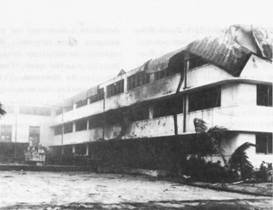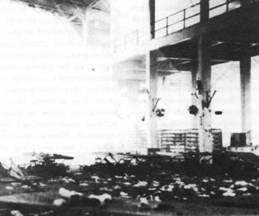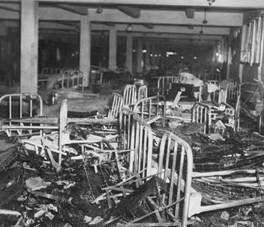|
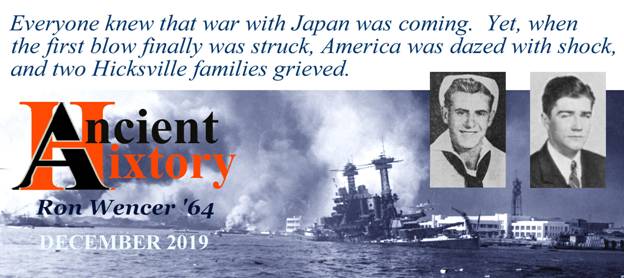
***
Introduction
Note: If you're familiar with the attack on
Pearl Harbor
and the history that led up to it, you may wish to skip to the next
heading.
In 1904, negotiations to resolve
conflicting regional ambitions between
Russia
and
Japan
broke down. The Imperial
Japanese Navy then launched an attack upon
Russia
's fleet, a day before war
was declared. Later, when
the war ended,
Japan
was recognized as a major power, and it would be invited to important
global conferences for years to come.
When historians ponder the
Pearl Harbor
attack, some find parallels to 1904.
In the early 1940s, American-Japanese negotiations were
prolonged, perhaps because
Japan
needed time in which to prepare for war.
Late in November 1941, it made a final proposal for peace in the
Pacific. Five days later, the
U.S.
countered that proposal with an ultimatum.
As expected,
Japan
rejected it - but even before the ultimatum was delivered, an Imperial
Navy task force had set out for
Hawaii
. A declaration of war was
delivered only after the attack began.
*
For many reasons,
Pearl Harbor
should have been better-prepared for the attack, but it was not.
On that December 7th, as on other Sunday mornings, it
was defended only lackadaisically. Many
officers were not on ships or at airfields, but in their homes in
Honolulu
. Those who oversaw the
radar had not been put on special alert, and casually assumed that the
approaching aircraft were American.
Much of the ammunition that defenders would need was locked away
- after all, it was Sunday morning, right?
American sailors and soldiers had never been taught to quickly
tell by its silhouette if an airplane overhead was American or not.
The swift attack was both
disorienting and disabling. Its
first wave (there were two) met little opposition, in large part because
it took time to break out ammunition.
People on the ground resorted to shooting at speeding aircraft
with rifles or pistols. The
noise of screaming engines, airborne gunfire, sirens, and explosions
made it hard to think clearly; it was hard to hear, let alone obey, any
orders that were shouted. Things
had improved by the time the second wave arrived.
A number of defensive guns now were armed, especially on some of
the ships. Several Japanese
planes were downed - but so were some of the few American planes in
the air. Some panicked
defenders shot first and looked for insignia later, targeting all the
aircraft they saw, whether or not they were Japanese.
The defenders did their best, but
their best did not count for much.
Pearl
was left a shambles of wrecked, even sunken, ships.
The airfields, also primary targets of the attack, were cratered
ruins. More than 3,500
Americans lay dead or wounded, strewn wherever they happened to fall -
some near their guns, where they had chosen to risk their lives in
defense of their country.
***
From Hicksville to
Oahu
Two young servicemen from
Hicksville
were caught in the attack. These
are their stories.
Cleveland
John
Dodge
In December 1939,
Europe
was already at war. That
month, 19 year-old Cleveland Dodge, Jr. of West Marie Street enlisted in
the Navy. No doubt his
father, active in Hicksville's Veterans of Foreign Wars Post,
understood - he had served many years in the Navy himself, including a
long stretch during World War I when his ship and its crew were interned
in Constantinople (now
Istanbul
).
Following
training in
Newport
,
Rhode Island
, young Dodge was assigned to the flagship of the country's Battle
Fleet, the "Tennessee
Class"
California
.
The battleship was 624' long, it could sail up to 9,000 miles
without refueling, and it carried a crew of 1,400.
In calm seas, it could fire 14" diameter explosive shells a
distance of about 20 miles. Really.
By December 1941, Dodge was a Seaman 1st Class,
assigned to one of the ship's magazines - a place far below deck
where ammunition was stored, until it was time to send it via hoists up
to the
California
's guns.
*
|

|
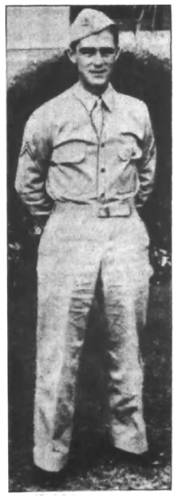
|
|
S1c
Cleveland
John Dodge
Dodge Family Tree on Ancestry
created by user fedcop84
|
PFC
John T. Haughey
Nassau Daily Review-Star
March 30, 1942
|
*
John
T. Haughey
John Haughey grew up in a large family on
Third Street
. After completing his
studies at
St.
Ignatius
School
, he went on to
Hicksville
High School
. John was one of eleven
seniors who graduated in January 1940.
Two months later, he enlisted in the Army, and soon found himself
stationed in
Hawaii
as part of the Army Air Corps (the first incarnation of the Air Force).
He was based at then-new Hickam Field, about a mile from
Battleship Row, where he lived in the three-storey Consolidated
Barracks. John was assigned
to the 50th Reconnaissance Squadron of the 11th Bomber Group as a radio operator.
His unit flew new B-17D bomber aircraft, in which it was training
for long-distance missions over the Pacific, missions intended to
monitor and photograph Japanese activity.
John
quickly developed a fondness for flight; he wrote to his family about
the flying classes he was taking at the
University
of
Hawaii
. His letters even mentioned
the possibility of his being transferred back stateside for Air Corps
pilot training.
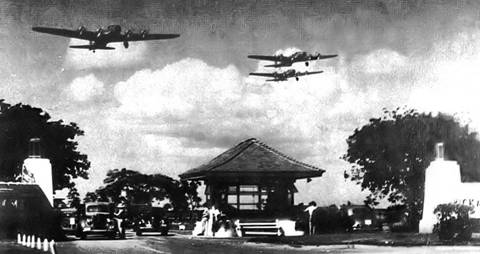
1941:
Main Entrance to Hickam Field, with B17Ds overhead
Bowman, B-17 Flying Fortress Units of the Pacific War
***
The Attack
S1c
Cleveland
Dodge
Working in a battleship's magazine was not an easy job.
Munitions had to be stowed and retrieved carefully; a stray spark
of static electricity might destroy enough of the ship to sink it.
Gunpowder was stored below the waterline; in the event of a fire
above, the powder rooms would be flooded immediately, likely drowning
those who served there. When
the guns were firing, ammunition (and also, for the big guns, canisters
of powder) had to be loaded, quickly and without accident, into hoists,
and then transported to the guns above.
When the attack began, the
California
's Lt. Commander (the
ranking officer then on board) ordered its crew to their battle
stations. He then had the
boiler room start building up steam for the ship's turbo-electric
engines, intending to move the battleship into the open sea, where it
could draw the attack away from
Pearl Harbor
, and from where he might launch a long-distance counter-attack against
the Japanese. The limited
supply of on-hand ammunition soon ran out; the rest was locked in the
magazines. To get more,
crewmen had to run down to the lower decks and gain access to the
magazines.
Meanwhile, torpedo bombers were targeting the ship, and one torpedo
struck home. Normally, the
resulting flood of incoming water might have been staunched, but an
inspection had been scheduled for that morning, and many watertight
doors stood wide open. The
water spread quickly through the hull.
Next, bombs fell from above and hit the ship, killing scores of
the crew and igniting a fire. Although
the fire was ultimately extinguished, the ship lost power, rendering it
indefensible, and it was abandoned.
It sank slowly, coming to rest on the mud beneath
Pearl
's shallow waters, so that it listed to port.

As ships and oil burn on the water,
U.S.S. California settles on
Pearl Harbor
's bottom.
Naval History and Heritage Command
https://www.history.navy.mil/
PFC John Haughey
On Saturday night, Haughey had fallen
asleep in his bed in Hickam Field's barracks.
By 8:00 AM Sunday, a number of soldiers had gone to breakfast in
the mess hall. Some early
birds were back already, getting ready for their day, and Saturday's
night owls were still trying to sleep late.
The sound of gunfire - at first, it sounded like artillery
practice - annoyed them.
People looked out the windows as a dive bomber dropped its payload
on the
Air
Depot
Building
. Not yet comprehending what
they saw, they watched the airplane level off and fly towards the
barracks. As it passed
overhead, they could see the large red disks painted on its wings.
Only then did they understand.
Before they could react, bombs were exploding in the hangars next
door. Then more bombs
pierced the roof overhead and penetrated the barracks.
Explosions sent beds, equipment, shards of window glass, and
bodies through the air. Men
ran down the stairs and out to the lawn, where they met comrades who had
fled the mess hall. Not
knowing where to go, those who remained in the open were strafed (i.e.,
machine-gunned by planes flying low overhead).
Those who still could flee did, scattering anywhere and
everywhere.
***
News, Then No News
News of the attack quickly reached the
United States
, and war was declared. President
Roosevelt tried to inspire and reassure the country, but in the days
that followed, reassurance was hard to come by.
The essence of what happened was known; many horrifying details
had been reported, or were easy to infer.
Although every family in the country with someone stationed in
Honolulu
worried, most of those families would hear nothing for weeks.
For now, cataloguing the missing and the dead would have to wait.
The first priorities were making
Oahu
defensible, tending to its injured, and repairing its infrastructure.
There was an abundance of highly-motivated men to do that work,
servicemen who on paper were still assigned to unusable ships or
aircraft. They helped clear
debris, repave roads and runways, move building supplies, and do
whatever else they could. Many
guns on sunken warships were still above-water and usable.
Navy men helped re-purpose them into new land-based anti-aircraft
and artillery batteries.
Gradually, things stabilized, and people could tackle the job of
compiling lists of casualties and missing personnel. Both
the attack and the subsequent rebuilding effort had scattered servicemen
around the island. One could
only work from whatever lists or muster rolls could be found.
People who were not with their assigned units, or among the
identified dead or injured, were "missing" - but in reality, they
might be alive and well, working somewhere on an important but impromptu
task. It would serve no good
purpose to send "missing in action" telegrams to the families of
such people yet.
Tracking everyone down was important, but it had to be done
thoroughly and carefully.
***
Word Reaches Hicksville,
Bit by Bit
December
In mid-month, Cleveland Dodge's parents received official notice that
he had been killed in action. His
was the first reported war death of a man from
Hicksville
. The high school began
preparations for a memorial service.
Both his brothers, who worked at Grumman, were motivated by their
family's loss, and they enlisted - one in the Navy, the other in the
Army Air Corps.
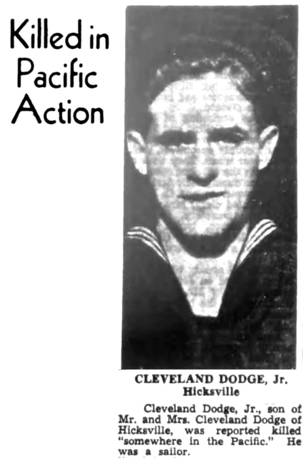
Nassau
Daily Review-Star, December 31, 1941
Several days later, just before
Christmas, the Haughey family was notified that John Haughey was
missing. Now two
Hicksville
families had reason to be glum during the holidays.
*
A
New Year Begins
Incredibly, on January 1st, the Navy Department informed
Cleveland Dodge's family that he was NOT dead.
Having passed a dour New Year's Eve, they suddenly had joy to
spare on New Year's Day. Later,
they would learn that their experience had not been unique - around
the same time, a Syosset family also was informed that the earlier
report of a son's death had been erroneous.
Not only was young Dodge alive, but he
was unharmed. During the
attack, he had been at his battle station, closed into one of the
ship's magazines. As the
California
slowly sank, its magazines flooded, and water blocked their exits.
Crewmen clambered up the ammunition hoists to the main deck.
Until the ammunition on the main deck ran out, Dodge helped man
the ship's guns. Over the
weeks since the attack, he had been helping to remove guns from sunken
ships and helping install them in the new batteries being built around
Honolulu
.
To absolutely no one's regret, his memorial ceremony at the high
school was canceled.
*
In mid-January,
America
's headlines announced the death of actress Carole Lombard - a fan
favorite, and wife of Clark Gable. She
had died in an airliner crash, while flying home from a rally at which
she had urged people to buy Defense Bonds.
Those who picked up the Review-Star
to read the story spotted another item of interest on the front
page:
|

|
|
Nassau
Daily Review-Star
January 17, 1942
|
More news about John Haughey would
follow. Two days later, word
came that he had been posthumously awarded a Purple Heart.
Many weeks thereafter, near the end of March, the government
finally issued a public announcement of his death.
John, one of eight men from the 50th
Reconnaissance Squadron who died in the attack, had been found in
the disarray of Hickam Field's barracks / mess hall complex.
***
Conclusion
Cleveland
Dodge
A month after he re-emerged, the Navy officially transferred Cleveland
Dodge from the sunken
California
to a Command responsible for Anti-Aircraft Shore Batteries.
In other words, he was to continue the work he had been doing,
but now it was official.
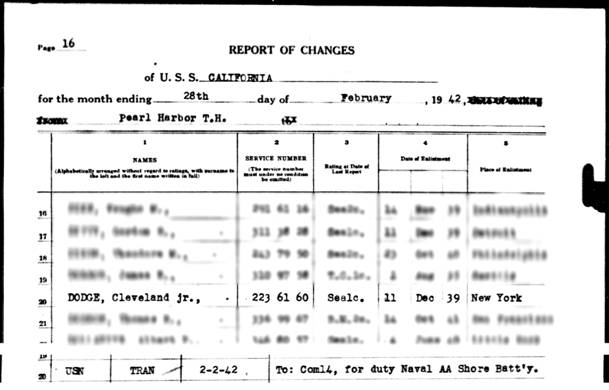
Excerpt of Muster Roll of U.S.S. California,
February 1942
Ancestry.com
When
the job was done, Dodge was transferred to U.S.S.
West Virginia, where he became a Signalman.
Several months later, he was sent to the destroyer U.S.S. Owen, on which he remained for the duration of the war,
taking part in many battles in the Pacific.
After
the war, he married, moved to
Levittown
, and raised a family. He
passed away on January 1, 1999 - the anniversary of the day on which
his parents learned that he had returned from the dead.
He was buried in
Calverton
National
Cemetery
.
*
John
Haughey
On January 26, 1942, much of
Hicksville
turned out to honor the town's first person lost in World War II.

Nassau
Daily Review-Star
January 27, 1942
Over
the preceding weeks, news from the Pacific had (unavoidably) been
confused, and for many Hicksvillians, the confusion magnified the shock
of the war's onset. They
had watched as one local family's grief turned to joy, even while
another's hopes collapsed into despair.
By
this date, it was known that a total of six servicemen from
Nassau
County
had been lost on December 7th.
Like PFC Haughey, two other soldiers died at the Hickam mess hall
/ barracks: one from
Woodmere
, and one from
Mineola
. The other three men lost
were sailors, all of whom died in the U.S.S. Arizona. They
were natives respectively of East Meadow, Roosevelt, and
North Merrick
.
*
After the war, PFC John T. Haughey's remains were
re-interred, high atop an old volcano in the peace and beauty of the National
Memorial Cemetery of the Pacific.
|
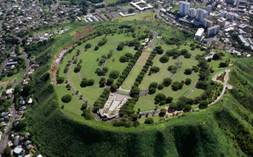
|
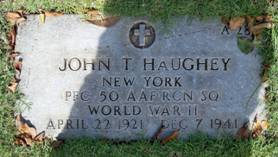
|
|
National
Memorial
Cemetery
of the Pacific
Punchbowl Crater,
Honolulu
https://htourshawaii.com/
|
Findagrave.com
Jeff Hall photo
Note the 'AAF' on the marker.
Transition from 'Army Air Corps' to 'Army Air
Force' was both complicated and prolonged; it was not
completely resolved until the war's end.
|
*
Wherever they lie, may S1c Cleveland Dodge, PFC
John Haughey, and all the rest of those who faced the attack on
Pearl Harbor
rest in peace.
***
Sources
Wikipedia, Attack on Pearl Harbor
https://en.wikipedia.org/wiki/Attack_on_Pearl_Harbor
National Park
Service
,
U.S.
Army Air Forces Casualties
https://www.nps.gov/valr/learn/historyculture/us-army-air-forces-casualties.htm
Naval History and Heritage Command, World
War II
https://www.history.navy.mil/browse-by-topic/wars-conflicts-and-operations/world-war-ii.html
The Pacific War Online Encyclopedia,
U.S. Battleships, Tennessee Class
http://pwencycl.kgbudge.com/T/e/Tennessee_class.htm
U.S. Navy, World War II Navy
Muster Rolls
Ancestry.com
American Air Corps Library and Museum,
WW II Photo Albums
https://www.armyaircorpsmuseum.org/
7 December 1941: The Air Force
Story, Chapter V
www.ibiblio.org/hyperwar/AAF/7Dec41/7Dec41-5.html
Martin Bowman
B-17 Flying Fortress Units of the
Pacific
War
Hicksville
High School
, Comet Yearbooks, 1938 - 1940
Dodge Family Tree
Ancestry.com
Vital records, Census data, etc.
Ancestry.com
Nassau Daily Review-Star
numerous editions
Edward Jablonski, AIRWAR: Tragic
Victories
(Greater
East Asia
Co-Prosperity Sphere / Hark! The Voice of the Moment of Death)
Find A Grave
findagrave.com
Tours
Hawaii
,
Punchbowl
National
Cemetery
(sic)
https://htourshawaii.com/Punchbowl-National-Cemetery/
*****
|






